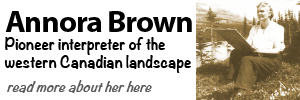JOYCE SASSE – GAZETTE CONTRIBUTOR
Annora Brown felt a great affinity for the native people who are neighbours to Fort Macleod.
As a child she loved to hear the sounds of their drums and their singing when they camped on the edge of town for special events.
She acknowledged them as “the original naturalists and poets of the country . . . who added so greatly to the world’s collection of beautiful art.”
She remembered spiritual elder Joe Crowshoe saying, “We are a lost and bewildered generation,” caught between the ways of the old people and the pull of the world that surrounds us.
So Brown felt a compulsion to preserve, in words and with paint, records of contemporary indigenous ceremonies, culture and designs. She knew that for them, as for herself, the West had indeed changed so much since she was a girl.
J.M. Dent and Sons included many of her illustration in their textbooks. Local newspapers carried stories she wrote about tipi designs, illustrated “uses for the buffalo” and stories about the teachings of the people.
Thirty oil and watercolour canvases of her native art from the Glenbow collection will be photographed and digitized by mid-September.
She was able to capture the colour and action of the hoop dance. Then in a totally different style she communicated the rhythm of the prairie chicken dance (which was one of eight works of art selected for the 1955 Alberta Golden Jubilee Anthology).
In her thesis, Patricia Alderson underscores Brown’s attempt to try to capture the true spirit of aboriginal life. One of Brown’s family members passed on the story of when she visited Bob Tailfeathers at his home. He was in his 90s and quite ill. But he got dressed in his regalia and sat on the side of his bed while she sketched for the painting. He died soon after that visit, but his co-operation under such circumstances shows the respect he had for her.
A church service on “Walking in Annora Brown’s Footsteps” will be held on Sunday, June 26 at 11 a.m. at Trinity United Church.
We will reflect on how the landscape of the Oldman and Waterton River region helped this artist-conservationist face adversity, find courage, see beauty and cling to hope.

